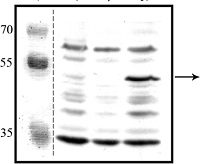1

Anti-CpxA | Conjugative plasmid expression
AS13 2653 | Clonality: Polyclonal | Host: Rabbit | Reactivity: Yersinia pseudotuberculosis
- Product Info
-
Immunogen: Recombinant CpxA (residues 26 to 168) over-expressed as a N-terminal fusion with His(x6)-tag, which was removed prior to immunization. The antigen originates from enteropathogenic Yersinia pseudotuberculosis YPIII; B1JQV1, NCBI annotated locus tag YPK_4133.
Host: Rabbit Clonality: Polyclonal Purity: Serum Format: Lyophilized Quantity: 50 µl Reconstitution: For reconstitution add 50 µl of sterile water Storage: Store lyophilized/reconstituted at -20°C; once reconstituted make aliquots to avoid repeated freeze-thaw cycles. Please remember to spin the tubes briefly prior to opening them to avoid any losses that might occur from material adhering to the cap or sides of the tube. Tested applications: Western blot (WB) Recommended dilution: 1 : 2000 (WB) Expected | apparent MW: 51.8 | 52-53 kDa - Reactivity
-
Confirmed reactivity: Yersinia pseudotuberculosis Not reactive in: No confirmed exceptions from predicted reactivity are currently known - Application Examples
-
Application example
Aliquots of 20 µL total cell lysate, derived from 1 ml of pelleted Y. pseudotuberculosis YPIII bacteria (absorbance at 600 nm of ~1.5) that was extracted with 200 l 1x loading buffer, were separated by 12 % acrylamide SDS-PAGE and then wet-blotted for 1h to Immobilon®-P PVDF membrane (Millipore). Following transfer, the membrane was blocked immediately in milk solution (10 % milk powder in TBST) for 1 h at room temperature with agitation. Membrane was incubated in the primary antibody at a dilution of 1:2000 overnight at 4 °C with agitation. The antibody solution was decanted and the membrane was washed twice for 15 min in TBST at room temperature with agitation. The membrane was incubated in secondary antibody (anti-rabbit IgG conjugated horse radish peroxidase and sourced from GE Healthcare) diluted to 1:10000 for 1h at room temperature with agitation. The membrane washed as above for 45 min and then CpxA detected with homemade ECL detection reagent. Exposure time was 180 seconds.
Lanes: Marker: PageRuler™Plus Prestained Ladder (ThermoScientific)
Wildtype: Y. pseudotuberculosis YPIII/pIB102
cpxA: Y. pseudotuberculosis YPIII07/pIB102 (cpxA in frame deletion of codons 41 to 449) [Carlsson et al., Infect. Immun., 75 (2007), pp. 3913–3924]
cpxA101*: Y. pseudotuberculosis YPIII/pIB102 (cpxA allele encoding for the substitution of T253P) [Liu et al., PLoS One, 6 (2011), p. e23314]
Courtesy of Dr. Matthew Francis, Umeå University, Sweden
- Additional Information
-
Additional information: The strains were grown in LB broth until late stationary phase (absorbance at 600nm of ~1,5), To avoid interference from cross-reacting bands, aim to maximize protein separation with the region of 35 to 55 kDa, CpxA could be routinely detected from a 20 µL of sample that was derived from 1ml of pelleted bacteria resuspended in 200 µl of 1x loading buffer, Re-use of diluted working strength antibody is not recommended - Background
-
Background: CpxA (Conjugative Plasmid Expression) is the 458 amino acid protein, a bacterial inner membrane histidine protein kinase, responsible for sensing misfolded proteins in the periplasm. It is part of CpxA/CpxR two component signal transduction system, where CpxR is the cognate response regulator. In sensing bacterial envelope stress, the Cpx pathway regulates the production of a number of periplasmic folding and trafficking factors to maintain outer membrane integrity. It is also responsible for global control of virulence factor expression. Alternative name: Integral membrane sensor signal transduction histidine kinase.
- Protocols
-
- Reviews:
-
This product doesn't have any reviews.


